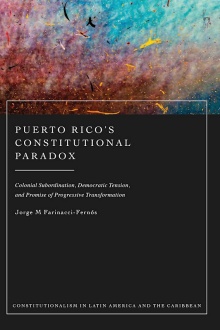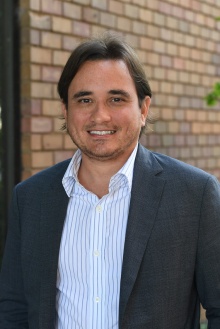Assessing an island’s constitutional experiment
“Puerto Rico’s Constitution is very inspiring,” says Visiting Assistant Professor Jorge Farinacci-Fernós, a native of the island, “but it is absolutely colonial. It’s very progressive, but it has not been used adequately. It’s extremely democratic, but the institutions it created were not.”

Purchase this publication from Bloombury Publishing Inc.
There’s a word for internal contradictions like that, and it’s in the title of Farinacci-Fernós’ newly published book: Puerto Rico’s Constitutional Paradox (Bloomsbury). Subtitled “Colonial Subordination, Democratic Tension, and Promise of Progressive Transformation,” the volume looks at the tensions inherent in Puerto Rico’s 1952 Constitution—the only constitutional document written by the Puerto Rican people after more than 500 years of Spanish and U.S. colonial rule.
The author takes a deep dive into the history and substance of the island’s Constitution and how it was created, focusing new attention on its progressive polices such as guarantees of human rights, and the governmental structure it set up that has endured for 70 years. He also lays out some of the challenges to fully realizing the Constitution’s ideals, such as underenforcement by the judicial system and “blind spots” in the document itself.
Farinacci-Fernós, who is an associate professor at the Interamerican University of Puerto Rico Law School, reflected on the project in a recent conversation with UB Law Links.

You write that social movements in Puerto Rico are reflected in the island’s Constitution. Can you give an example of how that plays out in the document?
Nearly a quarter of all the provisions found in the Puerto Rico Bill of Rights deal in some way or another with labor and employment issues, ranging from overtime pay to the right to strike. This is the result of the significant presence of union leaders and farmworkers as delegates to the Constitutional Convention. It also reflects the political reality of 1952, when social justice and labor relations were top on the agenda. In that sense, Puerto Rico’s Constitution is a sort of workers’ constitution. Unfortunately, the decline in labor’s strength has weakened the force of pro-worker provisions.
Spanish and U.S. colonial rule obviously left an indelible mark. How did the Puerto Rican Constitution respond to that legacy?
Unfortunately, the Puerto Rican Constitution is part of the legacy of colonialism inherited from Spain and the United States. That is one of its most essential contradictions: a document that purports to state the sovereign will of “We the People of Puerto Rico” has functioned to strengthen our colonial status. That is why our Constitution can be described as colonial and democratically deficient, but at the same time as social and progressive. That is the type of paradox the book attempts to identify. At best, Puerto Rico’s current constitution is a victim of colonialism. At worst, it has enabled it further.
The Constitution has provisions guaranteeing human dignity and equality under the law, as well as protections against discrimination. The emphasis on these ideas seems quite modern; how is it that the framers made them a priority 70-plus years ago?
The Constitutional Convention met at a unique moment in world and Puerto Rican history. Our Constitution was written seven years after the end of the Second World War and three years after the adoption of the Universal Declaration of Human Rights. Our founding generation was characterized by the spirit of the age: progressive, social and community-oriented. After centuries of colonial domination and material exploitation, the constitutional drafting process became an opportunity to at least address some of these historical and structural ills. The Constitution was meant to be an ally of progressive goals that focused on essential human dignity, equality, and justice.
The COVID-19 pandemic tested the limits of the Constitution’s guarantee of freedoms. In your view, did the balance tip too far toward restrictions on people’s autonomy?
Section 19 of the Puerto Rico Bill of Rights has three main components. First, it requires courts to adopt a broad and expansive interpretation of constitutional rights. Second, it recognizes the existence and operation of unenumerated rights. And third, it explicitly grants considerable police powers to the Legislative Assembly to enact laws to protect the general welfare. This means that individual rights and government power are not seen as inherently contradictory. Quite the opposite, they are both needed to achieve a more just and democratic society.
In addition, the experiences after Hurricane Maria taught us the importance of looking out for one another and getting through great challenges collectively. This explains why the Puerto Rican response to the COVID crisis was significantly effective: although many executive orders were issued, most people put on their masks and got their vaccines voluntarily. The only way we were going to overcome the crisis was together.
What can scholars of the U.S. Constitution learn from Puerto Rico’s constitutional project?
Puerto Rico’s constitutional project has a lot to offer constitutional scholars around the world. As with any paradox, there are positive characteristics and more negative ones. On the positive side, we can point to an open and quite democratic process of creation that incorporated citizens and civic groups. The substantive content of our Constitution should also be looked at, including our enforceable provisions addressing human dignity, anti-discrimination, privacy, education, labor conditions and environmental protections. Many of our individual rights transcend state action and do not require further legislation. As to the negative side, the Puerto Rican experience can serve as a warning regarding the unacceptability of colonialism and the need to continuously expand mechanisms of democratic, popular self-government.